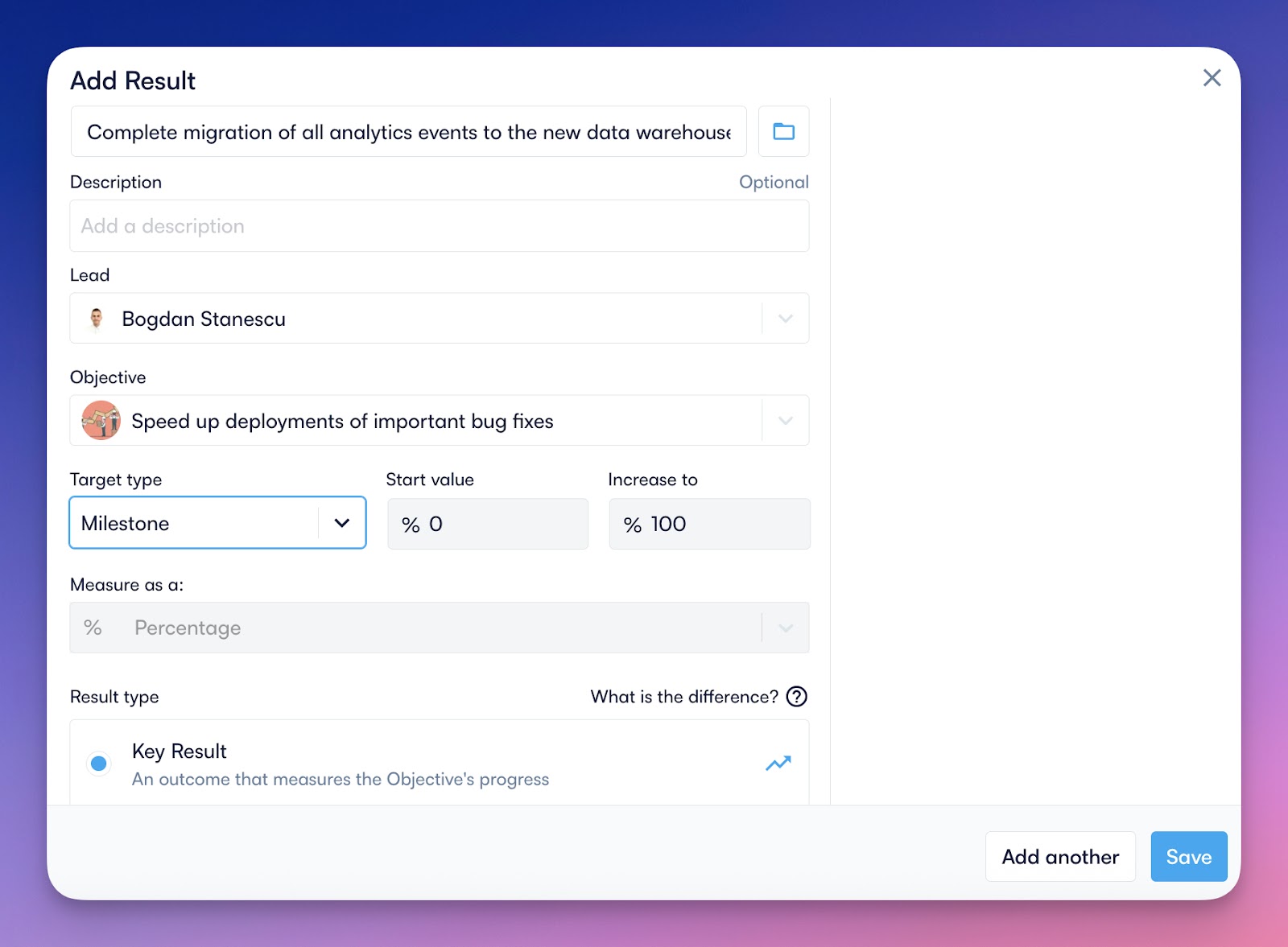
Initiatives CAN drive progress on Objectives
In the OKR framework, progress on an Objective is traditionally measured by its Key Results. After all, the acronym OKR stands for Objectives and Key Results.
Objectives are meant to be inspirational, while Key Results define what success looks like in concrete, measurable terms. Initiatives are then the projects and tasks that help move the needle on those Key Results. Since they’re a means to an end, completing them doesn’t guarantee business success. This is why outcome-based Key Results are the gold standard for measuring Objective progress.
It can be tempting to simply convert an Initiative into a Key Result. But thoughtlessly doing so defeats the purpose of Key Results: measuring impact, not activity. Conflating execution (Initiatives) with results (Key Results) can lead to a false sense of progress and dilute the focus on what actually matters. Some companies deliberately avoid turning Initiatives into Key Results out of respect for the clear distinction between outcomes and outputs.
For these reasons, sometimes it feels more natural to have progress of an Objective be driven by Initiatives. Here are a few examples.
Output-oriented goals
OKRs are about driving change, so you’re either building, improving or innovating. When you’re focused on improving or innovating, it’s often easier to identify outcome-oriented metrics for Key Results. But when you're in a foundational phase — like building infrastructure or setting up internal processes — you're laying the groundwork for future capabilities, so the impact often comes later. Therefore, success is more realistically measured at this time by outputs.
Take this example:
In this case, success is defined by these clear, concrete deliverables. It’s the important work that needs to be completed to ensure a solid foundation has been achieved.
These major deliverables may also be broken down into smaller deliverables. For example, completing the migration of all analytics events to the new data warehouse requires auditing existing events, mapping them to the new schema, updating tracking code, and validating the data in the new environment. Similarly, implementing data governance policies might involve defining ownership for each dataset, creating documentation templates, and running review sessions with relevant stakeholders.
Due to the nature of this goal, it makes sense to convert the major milestones, such as completing the migration or implementing governance policies, into Key Results. While they're output-oriented, they still represent meaningful progress toward the Objective. From there, Initiatives can be used to break those Key Results down into concrete actions and tasks. Completing the Initiatives directly drives progress on the Key Results, and achieving those Key Results signals that the Objective — in this case, laying a scalable data foundation — is on track. Essentially the Objective’s progress is driven by its Initiatives propagating up into its Key Results.
It’s too hard to quantify success
In some domains, such as research and development, legal work, or early-stage exploration, outcomes are often ambiguous, long-term, or qualitative. In these cases, tracking outputs feels more appropriate for the nature of this work.
For example, consider a team assessing a potential market expansion:
Objective: Explore feasibility of expanding into the APAC market
In a situation like this, the team isn’t yet trying to achieve market expansion; they’re evaluating whether it even makes sense. Measuring outcomes like revenue or customer growth would be premature. Instead, success is better defined by completing essential steps that inform the decision:
- Conduct market research in at least 3 priority APAC countries
- Identify and document legal and regulatory requirements for each country
- Interview 10 potential local partners or customers
- Deliver a yes/no recommendation with supporting analysis by end of quarter
In exploratory phases, the goal is to reduce uncertainty, not drive immediate results. Completing this work represents real progress and value.
Early in the OKR cycle
In the first few weeks of an OKR cycle, it’s common to see little or no movement in your Key Results. That doesn’t mean your team isn’t making progress. Often, the early part of the quarter is spent setting the stage: aligning stakeholders, conducting research, or kicking off projects.
In these cases, Initiatives can provide early signals that the team is on track, even if impact hasn’t shown up in the metrics yet. For example, if a Key Result is to increase qualified leads by 20%, you might not see measurable progress in the first few weeks. However, completing Initiatives like launching a paid campaign, or setting up lead scoring in the CRM indicates that the necessary work is underway to move the metric later in the cycle.
While this Initiative-based tracking can give teams a sense of momentum early on, it’s important to shift the focus back to outcomes as soon as it’s realistic to do so. Over-relying on Initiatives throughout the cycle can create a false sense of progress — after all, getting things done isn't the same as moving the needle.
New to working with OKR
We’re creatures of habit — and most of us are used to measuring success by what we do, not necessarily by what we achieve. That’s why, for organizations new to OKRs, the shift from tracking outputs to focusing on outcomes can feel like a big leap. It takes time to learn how to write meaningful Key Results, separate them from projects, and tie them to real business impact.
In the early stages of working with OKRs, it’s reasonable to adopt a transitional approach and start with Initiative-based progress. For example, a team may begin with a Key Result like “Launch new customer support portal”, which is clearly an output. Over time, as their OKR maturity improves, they can evolve that into an outcome such as “Reduce average support resolution time by 30%.”
Using Initiatives as temporary stand-ins for Key Results allows teams to get comfortable with the habit of tracking progress and aligning around goals. The key is to treat Initiative-based OKRs as a starting point, not the destination. Over time, teams should shift toward defining success based on the value their work creates — not just the work itself.
How Perdoo supports Objective progress based on Initiatives and outputs
In Perdoo, an Objective's progress is based on its Key Results by default. However, we do also provide the flexibility to allow Initiatives to impact progress of an Objective, in part or whole. You can apply this on a per-goal basis if any of the aforementioned situations apply.

For output-oriented Key Results, you can also use Milestone or Binary Key Results and/or have the Key Result’s progress be based on its aligned Initiatives.

Conclusion
While Objectives should ideally be measured by outcomes, there are situations where tracking Initiatives can be just as valuable. These Initiatives can help demonstrate progress, maintain momentum and help build confidence working with a new system.
FAQ


Ready to get started?
















